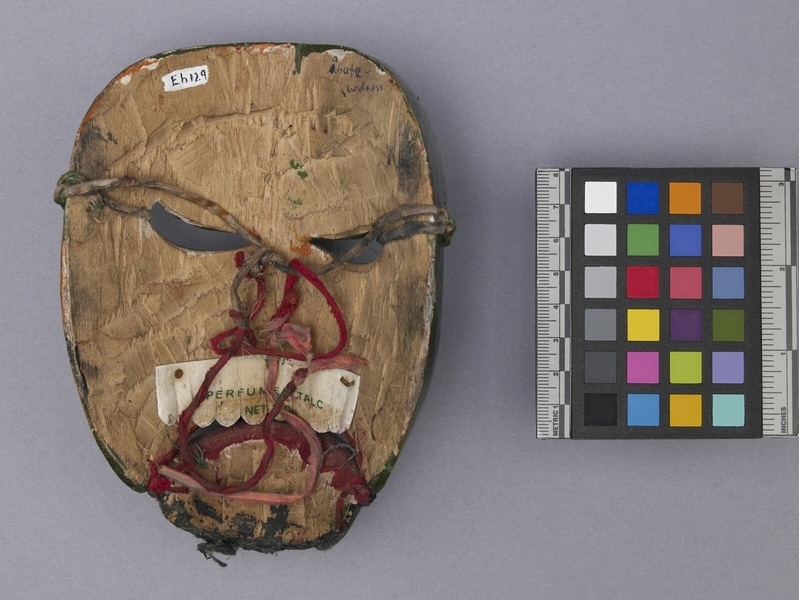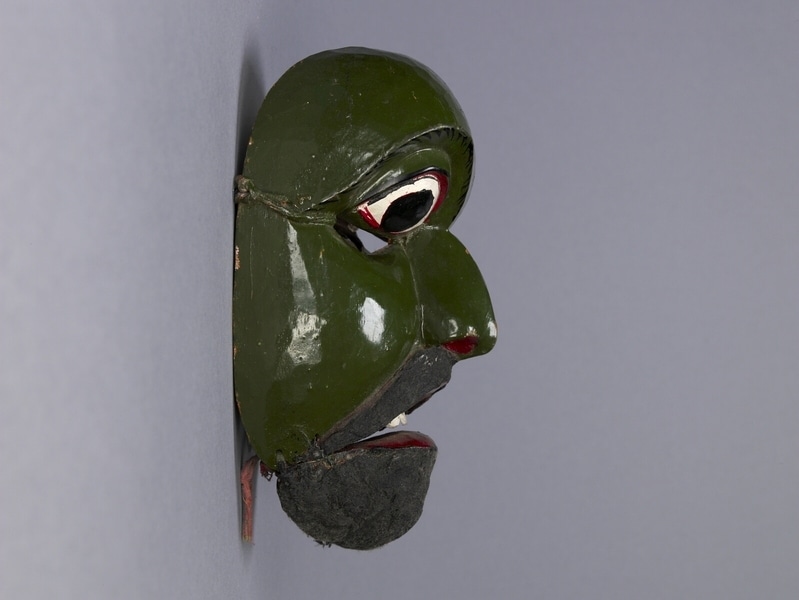Mask Item Number: Eh129 from the MOA: University of British Columbia




Description
Small, wooden humanoid mask painted in glossy dark green. Rounded forehead, black painted eyebrows. Large white painted eyes outlined in red with large black pupils; the plane of the eye socket slopes sharply backward and the eyes are bulging out of their sunken sockets. Slits for vision under the eyes, small bulbous nose with red nostrils; black beard and moustache of applied fabric, possibly wool. Open, downturned mouth with red lips; applied upper teeth cut from a single piece of plastic tacked to back of mask with the words "Perfumed Talc 100 gm" printed on back. The jaw is movable and affixed on either side with wire and red cord threaded through small holes. A fabric cord of red and dirty white is tied through each eye slit to attach mask to head of wearer. The mask appears to have an undercoat of orange paint. At the rear of the mask at the top is written in pencil, "abata undness".
History Of Use
Mask appears to be Vata Sanni which represents flatulence or the windy disease, pains in the limbs and even paralysis; or possibly it represents Abuta, a form of madness which often uses the same mask. The mask is used in a dramatic role to exorcise disease-causing demons. The Tovil ceremonies of Sri Lanka involve an exorcist, dancers and a drummer. Most important of the Tovil rituals is a cycle called Sanni Yajum or Sanni Natum, or demon- dancing ceremonies. Sanni means disease or malady. 18 ailments are believed to be caused by the Sanni demons. According to legend Buddha subdued the demons, gave them permission to accept oblations to cure the diseases they cause, and, thereafter, the demons are evoked whenever people are afflicted by these humors. Sanni dances are the last stage of the healing ceremony which may last many hours. Not all 18 demons need appear in each ceremony.
Iconographic Meaning
Several demons causing diseases are painted green including Vata Sanni.
Cultural Context
ritual;exorcism
Item History
- Made in Sri Lanka before 1983
- Collected during 1983
- Owned by Jeena Jewels
- Owned by Jason Schoonover before June 21, 1984
- Received from Museum of Anthropology Shop Volunteers (Funding source) and Jason Schoonover (Seller) on June 21, 1984
What
- Name
- Mask
- Identification Number
- Eh129
- Type of Item
- mask
- Material
- plastic, metal, wool fibre ?, cotton fibre, paint and wood
- Manufacturing Technique
- carved and painted
- Overall
- height 15.0 cm, width 11.0 cm, depth 10.0 cm
Who
- Culture
- Sinhalese
- Previous Owner
- Jeena Jewels and Jason Schoonover
- Received from
- Museum of Anthropology Shop Volunteers (Funding source) and Jason Schoonover (Seller)
Where
- Holding Institution
- MOA: University of British Columbia
- Made in
- Sri Lanka
When
- Creation Date
- before 1983
- Collection Date
- during 1983
- Ownership Date
- before June 21, 1984
- Acquisition Date
- on June 21, 1984
Other
- Condition
- fair
- Current Location
- Case 107
- Accession Number
- 0972/0019